In 2007, we started BLOG Zentangle and began our enjoyable series of conversations within our Zentangle community.
In reading through these blog posts with their insightful comments, we decided to bring a few of them to your attention from time to time. It is easy, for me anyway, to sometimes think of old information as stale information. But these insights and conversations are anything BUT stale!
We invite you to go back to the Twilight [Zen]Zone with this post from 2013...
Maria writes:
My thoughts were wandering recently (actually they wander quite often, without my consent or direction). I was trying to figure out just why Zentangle immediately gets me into that mindfulness state, when other art forms I practice do not.
What's different about the Zentangle Method?
I was thinking about the abstract-ness of it all, and that when I'm actually tangling on a Zentangle tile, I do not distract myself by looking away from my artwork for reference, confirmation or even inspiration.
Earlier I may have been looking . . . here and there . . . this way and that . . . for inspiration. I frequently add to my Zentangle "field notes" journal as I explore new tangle and deconstruction possibilities. But while I'm tangling, I just look at my tile. I'm not looking back and forth between my art and model, or at a photograph I'm trying to imitate, or admiring and trying to capture the momentary magnificence of a changing landscape or seascape.
When I sit down with a blank tile, I like to have an idea of the tangles I might use. I usually start out with one of my "mac 'n cheese" tangles, you know . . . "comfort tangles." Some of mine are mooka, purk, tripoli, poke leaf and maybe a bit of bales . . . old standbys. When I get a rhythm going I might throw in something different, maybe a new one I have seen in passing or a tangleation of one of Rick's (making his straight lines a bit curvier! :-) or just some auras around to elaborate existing tangles. But while I'm tangling, I just look at my tile . . . I rarely ever look up. Perhaps this uninterrupted concentration/focus on one place is one of the ways Zentangle works its magic for me.
Rick writes:
Last week we were talking with visitors about when Maria and I had our a-ha moment that became Zentangle. Our motivation to develop and share the Zentangle Method was not that it enabled her to create beautiful art - that was expected.
It also wasn't the idea that it might enable almost anyone to create beautiful art. Although important, I don't think that would have been enough to convince us to begin a whole new adventure while maintaining our regular work.
No, what convinced us was the significance of how Maria felt. We thought that if others could feel that good and just as easily create beautiful art . . . that would be a worthwhile adventure!
While Zentangle art is usually abstract (nonrepresentational), it is not an abstraction (something that exists only as an idea). Its results are beautiful to see; its experience, beautiful to feel.
Maria continues:
So, what about you? How do you think Zentangle draws you into that Zen-Zone of mindfulness?
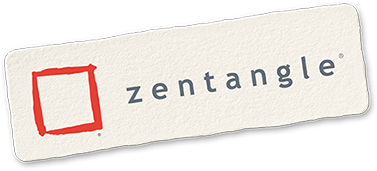
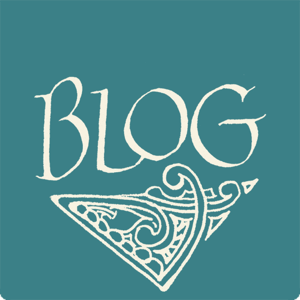
![Back to The Twilight [Zen]Zone](http://zentangle.com/cdn/shop/articles/zenzone1_1024x1024.jpg?v=1517943195)

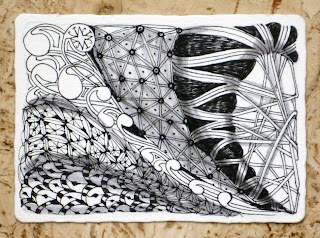
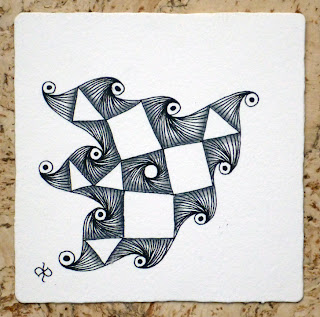
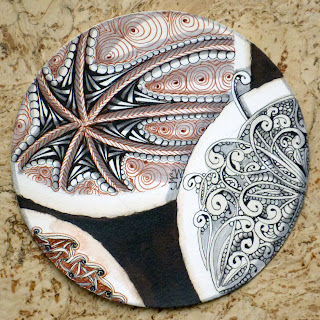
Zen zone to me is that place where I can rest. No expectations, no judgements, just me and a universe of opportunities. ; )
Jen on
Sue Leslie CZT on
Sharon Jerkovic on
Zentangle is the same. We try to be very aware of our drawing, very present, and not judge this part as good or that part as bad. It just is what it is. No Mistakes. And amazingingly, as we are present and as we trust the process, something happens. What comes up is the very best within us. Our gentleness and our kindness and our energy and our creativity. It shows up in our lives. And it shows up our Zentangles.
Mary Helen Fein, CZT on
Jane on
Aishwarya on
From the minute I pick up my pen, a sense of peace descends upon me. Pain dissipates and I lose all track of time. My pen takes me into a beautiful world of calmness. Shortly after I found Zentangle, my husband noticed this change in me when I tangled. I can’t explain it, I just feel it and embrace it and I’m ever so grateful for a few hours each day of feeling no pain.
Lesley Goldberg, CZT on
Anonymous on
Vandana Krishna, CZT on
Linda Dochter, CZT on
I love this art of repitition. Like Karan said, because I give my focus to my tile and little else, I can relax and enjoy the process. I sort of set aside my stressors and relax into my tile or journal where I practice new tangles and their variations. It’s like quiet time with God to me, without words or thoughts… just being.
Theresa on
Karan on